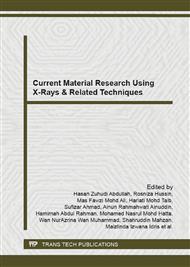p.30
p.35
p.40
p.45
p.50
p.55
p.59
p.64
p.68
Effect of Cu-Excess on the Microstructure and Microwave Dielectric Properties of CaCu3Ti4O12 Ceramics
Abstract:
CaCu(3+x)Ti4O12 (CCTO) ceramics with different Cu-excess (x = 0 – 0.6) were prepared by conventional solid-state reaction method. Characterization of the prepared ceramics with XRD and FESEM showed that lattice parameter and grain size are slightly increased, indicating Cu-excess to have the big impact on the both phase structure and microstructure. The XRD profiles indicated that the secondary phase (CuO or Cu2O) existed at edge/corner of CCTO grain, which promoted inhibited grain growth behavior. The CCTO ceramics exhibited two trends of dielectric constant related to frequency, which showed a flatter curve about ~50 in 1 – 25 GHz regions, and it’s dropped rapidly to ~35 in 25 – 50 GHz region. With Cu-excess, the dielectric constant of the ceramics was increased for an average of a quarter-order of magnitude, while the tangent loss also increased up to triple times than x = 0, for the same frequency range. Despite enormous increase of dielectric constant related to varying Cu-excess, the tangent loss also increased.
Info:
Periodical:
Pages:
50-54
Citation:
Online since:
February 2015
Price:
Сopyright:
© 2015 Trans Tech Publications Ltd. All Rights Reserved
Share:
Citation:


